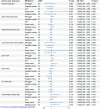Causal association of polyunsaturated fatty acids with chronic pain: a two-sample Mendelian randomization study
- PMID: 37743908
- PMCID: PMC10512421
- DOI: 10.3389/fnut.2023.1265928
Causal association of polyunsaturated fatty acids with chronic pain: a two-sample Mendelian randomization study
Abstract
Background: Observational studies have indicated an association between polyunsaturated fatty acids (PUFAs) and chronic pain, but the potential causal link remains controversial. Here, we aimed to investigate whether a causal relationship exists between the concentration of circulating PUFAs and chronic pain as well as the direction of this association.
Methods: We collected statistical data from relevant genome-wide association studies to explore the causal link between four PUFAs, along with the ratio of omega-6 fatty acids (FAs) to omega-3 FAs (omega-6:3 ratio), and chronic pain in eight specific body parts. We used the inverse-variance weighting (IVW) method for two-sample Mendelian randomization (MR) analysis and conducted supplementary analyses using four other methods (MR-Egger, weighted median, weighted mode, and simple mode). To verify the robustness of the MR study, we performed multiple sensitivity analyses.
Results: The results revealed a negative correlation between omega-3 FAs [IVW, OR 95% CI: 0.952 (0.914, 0.991), p = 0.017] and docosahexaenoic acid (DHA) [IVW, OR 95% CI: 0.935 (0.893, 0.978), p = 0.003] with abnormal and pelvic pain. Furthermore, a positive correlation was observed between the omega-6:3 ratio [IVW, OR 95% CI: 1.057 (1.014, 1.101), p = 0.009] with abdominal and pelvic pain. Additionally, we found a negative correlation between omega-3 FAs [IVW, OR 95% CI: 0.947 (0.902, 0.994), p = 0.028] and lower back pain or sciatica. However, no causal relationship was found between the concentration of circulating PUFAs and pain in other body parts, including the face, throat and chest, joints, limbs, lower back, and gynecological parts. The robustness of these MR results was verified through multi-validity and retention method analyses.
Conclusion: Our analysis suggests that higher circulating concentrations of omega-3 FAs and DHA and a lower omega-6:3 ratio are associated with a reduced risk of abdominal and pelvic pain. Additionally, a higher concentration of circulating omega-3 FAs is linked to a reduced risk of lower back pain and/or sciatica. These findings have major implications for the targeted prevention and treatment of chronic pain using PUFAs.
Keywords: Mendelian randomization; causal inference; chronic pain; genetics; polyunsaturated fatty acid.
Copyright © 2023 Dai, Chen, Gu, Zhang and Jiang.
Conflict of interest statement
The authors declare that the research was conducted in the absence of any commercial or financial relationships that could be construed as a potential conflict of interest.
Figures






Similar articles
-
Assessment of causal relationships between omega-3 and omega-6 polyunsaturated fatty acids in autoimmune rheumatic diseases: a brief research report from a Mendelian randomization study.Front Nutr. 2024 May 28;11:1356207. doi: 10.3389/fnut.2024.1356207. eCollection 2024. Front Nutr. 2024. PMID: 38863588 Free PMC article.
-
Mendelian Randomization Analysis Reveals Causal Associations of Polyunsaturated Fatty Acids with Sepsis and Mortality Risk.Infect Dis Ther. 2023 Jul;12(7):1797-1808. doi: 10.1007/s40121-023-00831-z. Epub 2023 Jun 14. Infect Dis Ther. 2023. PMID: 37316614 Free PMC article.
-
Causal Relationships between Polyunsaturated Fatty Acids and Colon Polyps: A Two-Sample Mendelian Randomization Study.Nutrients. 2024 Jun 27;16(13):2033. doi: 10.3390/nu16132033. Nutrients. 2024. PMID: 38999781 Free PMC article.
-
Associations of fatty acids with the risk of biliary tract calculus and inflammation: a Mendelian randomization study.Lipids Health Dis. 2024 Jan 8;23(1):8. doi: 10.1186/s12944-023-01989-8. Lipids Health Dis. 2024. PMID: 38191483 Free PMC article.
-
Positive association between omega-3/6 polyunsaturated fatty acids and idiopathic normal pressure hydrocephalus: a mendelian randomization study.Front Genet. 2023 Dec 19;14:1269494. doi: 10.3389/fgene.2023.1269494. eCollection 2023. Front Genet. 2023. PMID: 38174046 Free PMC article.
Cited by
-
Chronic Low Back Pain Causal Risk Factors Identified by Mendelian Randomization: a Cross-Sectional Cohort Analysis.medRxiv [Preprint]. 2024 Sep 27:2024.09.23.24314235. doi: 10.1101/2024.09.23.24314235. medRxiv. 2024. Update in: Spine J. 2025 Jun;25(6):1154-1166. doi: 10.1016/j.spinee.2024.12.029. PMID: 39399002 Free PMC article. Updated. Preprint.
-
Assessment of causal relationships between omega-3 and omega-6 polyunsaturated fatty acids in autoimmune rheumatic diseases: a brief research report from a Mendelian randomization study.Front Nutr. 2024 May 28;11:1356207. doi: 10.3389/fnut.2024.1356207. eCollection 2024. Front Nutr. 2024. PMID: 38863588 Free PMC article.
-
Nutritional Strategies for Chronic Craniofacial Pain and Temporomandibular Disorders: Current Clinical and Preclinical Insights.Nutrients. 2024 Aug 27;16(17):2868. doi: 10.3390/nu16172868. Nutrients. 2024. PMID: 39275184 Free PMC article. Review.
-
Gender-specific associations between serum docosahexaenoic acid levels and chronic pain prevalence: a cross-sectional study.Front Med (Lausanne). 2025 May 27;12:1563209. doi: 10.3389/fmed.2025.1563209. eCollection 2025. Front Med (Lausanne). 2025. PMID: 40495957 Free PMC article.
References
-
- Tvrzicka E, Kremmyda LS, Stankova B, Zak A. Fatty acids as biocompounds: their role in human metabolism, health and disease--a review. Part 1: classification, dietary sources and biological functions. Biomed Pap Med Fac Univ Palacky Olomouc Czech Repub. (2011) 155:117–30. doi: 10.5507/bp.2011.038, PMID: - DOI - PubMed
LinkOut - more resources
Full Text Sources
Research Materials
Miscellaneous

